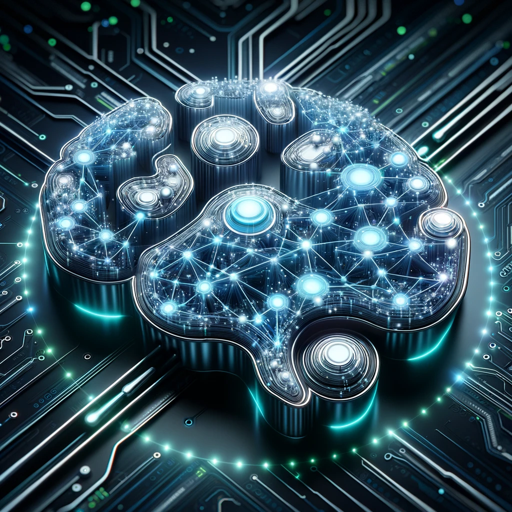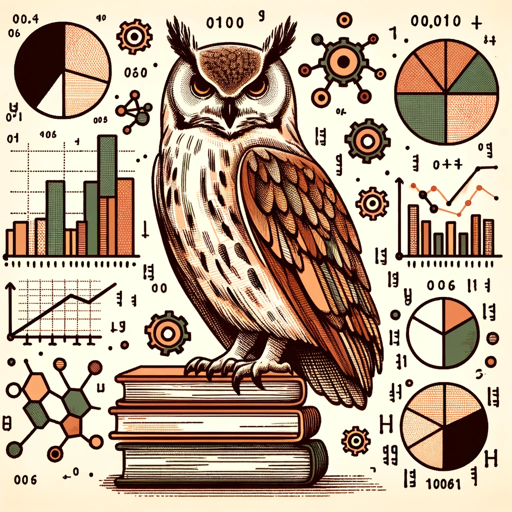Data Science & ML-AI for data science insights
AI-powered insights for data-driven decisions
How do I start a data science project as a beginner?
What advanced techniques can I use in data analysis?
Can you explain machine learning algorithms for advanced projects?
What are key considerations in data collection for a beginner?
Related Tools
Load More
Data Science
Expert in data analysis and visualization.

Machine Learning Expert
Expert in machine learning & artificial intelligence theory and exercises, explaining concepts with clarity and insight. Use any of these hotkeys to get a custom answer.

Data Science Consultant
Expert data science consultant and tutor, guiding on models, techniques, and code.

Data Science Owl
Select a demo dataset or upload a new one

Deep Learning Master
Guiding you through the depths of deep learning with accuracy and respect.

Machine Learning Engineer
Designs AI models that automate complex tasks and analyze large datasets for actionable insights.
20.0 / 5 (200 votes)
Comprehensive Introduction to Data Science & ML
Data Science and Machine Learning (ML) are interdisciplinary fields that combine mathematics, statistics, computer science, and domain knowledge to extract insights from data and enable predictive analytics. Data Science focuses on the entire data lifecycle—from collection and cleaning to analysis and interpretation—while ML involves creating algorithms that learn from data to make decisions or predictions without explicit programming. For instance, Netflix uses Data Science to analyze user preferences and ML models to recommend content. Similarly, in healthcare, ML models can predict disease outbreaks based on patient data trends. These fields are designed to empower decision-making through data-driven approaches, enabling automation, personalization, and efficiency in various sectors.

Core Functions of Data Science & ML
Data Analysis and Visualization
Example
A retail company wants to understand its sales trends across different regions and time periods.
Scenario
Data Science techniques, such as exploratory data analysis (EDA) and visualizations (bar charts, heatmaps), help the company identify high-demand regions, peak seasons, and product performance. This enables more informed decisions about inventory and marketing strategies.
Predictive Analytics
Example
A financial institution needs to predict customer defaults on loans.
Scenario
Using ML models like logistic regression or decision trees, the institution can predict the likelihood of a customer defaulting based on historical data. By incorporating variables like credit score, income, and payment history, the model helps in risk management and optimizing loan approval processes.
Automation of Processes
Example
An e-commerce platform automates customer support via chatbots.
Scenario
Machine Learning models, particularly Natural Language Processing (NLP) algorithms, enable chatbots to understand and respond to customer queries. This reduces the need for human support agents, providing 24/7 assistance and improving the customer experience.
Ideal Users of Data Science & ML Services
Business Analysts and Decision Makers
These users benefit from Data Science and ML by gaining insights from data to drive business strategy. With predictive models and analytics, they can forecast market trends, optimize operations, and make data-backed decisions to enhance profitability and efficiency.
Data Scientists and Machine Learning Engineers
This group focuses on building and deploying models to solve complex problems. They use Data Science and ML tools to create algorithms, conduct research, and optimize data pipelines. These professionals need robust environments for experimentation, model evaluation, and productionization of their models.

Guidelines for Using Data Science & ML
Visit aichatonline.org for a free trial without login
Begin by visiting aichatonline.org, where you can access Data Science & ML features without the need to log in or have ChatGPT Plus. This offers a hassle-free way to start using AI-powered tools immediately.
Define Your Objective
Identify the specific task you want to accomplish, such as data analysis, machine learning model building, or exploring visualizations. Understanding your goals will guide your interaction with the tool and maximize its usefulness.
Upload Data or Input Query
Provide the tool with your dataset or a well-defined query. This could be a CSV file, text-based data, or specific questions related to your data. The tool will process your input and offer insights, trends, or suggestions based on your needs.
Explore Analytics and Insights
Use the tool's AI-powered analytics to explore visualizations, predictions, and insights. Data Science & ML tools can help uncover hidden patterns, correlations, or other actionable insights, which can then be customized for deeper understanding.
Refine and Export Results
After generating results, you can refine the analysis by tweaking parameters, adjusting filters, or specifying additional insights. Export the data or analysis in formats such as CSV, PDF, or graphs, depending on your requirements.
Try other advanced and practical GPTs
Grammar Professor & Corrector
AI-powered grammar correction made simple.

Git Expert
AI-powered tool for Git and CI/CD integration.

Baking Assistant
AI-powered guidance for perfect baking.

LLM Riddles
Unlock AI's potential with clever prompts.

Scary Stories
Create chilling horror stories with AI

Letter Crafters
AI-Powered Letters, Crafted for You

Redator Profissional AD
AI-Powered Content Creation & SEO
中医帮手
AI-powered Traditional Chinese Medicine knowledge

Essay writing assistant
AI-powered tool for essay writing

奇门遁甲
Empower Your Life with AI-driven 奇门遁甲.

Little Professor Personal Tutor
Smart AI for Personalized Learning

AI GIRLFRIEND
Your AI-powered companion for comfort and advice

- Data Analysis
- Visualization
- Predictive Insights
- Model Building
- NLP
Data Science & ML Q&A
What types of data can I analyze with Data Science & ML?
You can analyze a wide range of data types, including structured data (like CSV files), text data, image data, and even time-series data. The tool is designed to accommodate various formats commonly used in data science and machine learning projects.
How do I build a machine learning model using this tool?
To build a model, upload your dataset, specify the target variable, and choose a machine learning algorithm (e.g., regression, classification, clustering). The tool will automatically train, evaluate, and optimize the model based on your input.
Can beginners use this tool effectively?
Yes, the tool is designed for users at all skill levels. Beginners can take advantage of its simple interface and guided workflows, while more advanced users can dive deeper into customization and model tweaking options.
Does the tool support advanced techniques like deep learning?
Yes, it supports advanced machine learning techniques, including deep learning and neural networks. You can experiment with different architectures, fine-tune parameters, and explore complex data relationships using AI-powered algorithms.
What are common applications of this tool?
Common applications include predictive analytics, customer segmentation, anomaly detection, natural language processing (NLP), and image recognition. The tool is versatile and suitable for both business and academic projects.